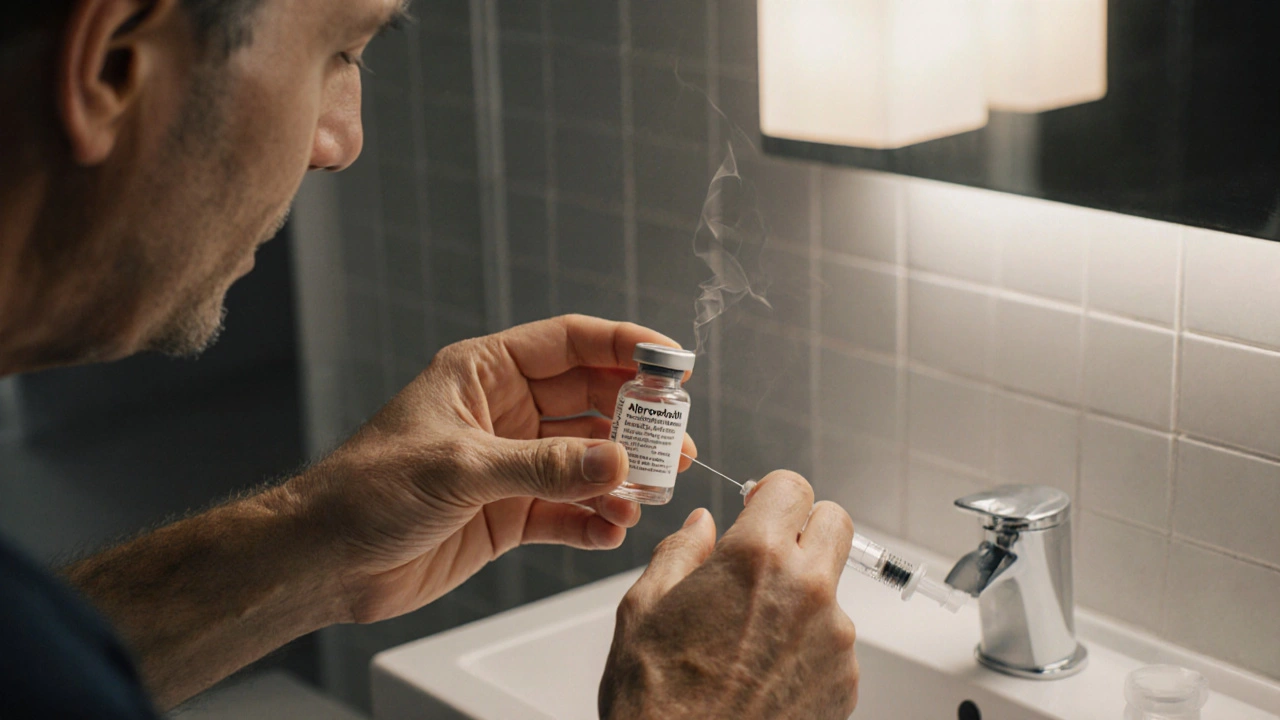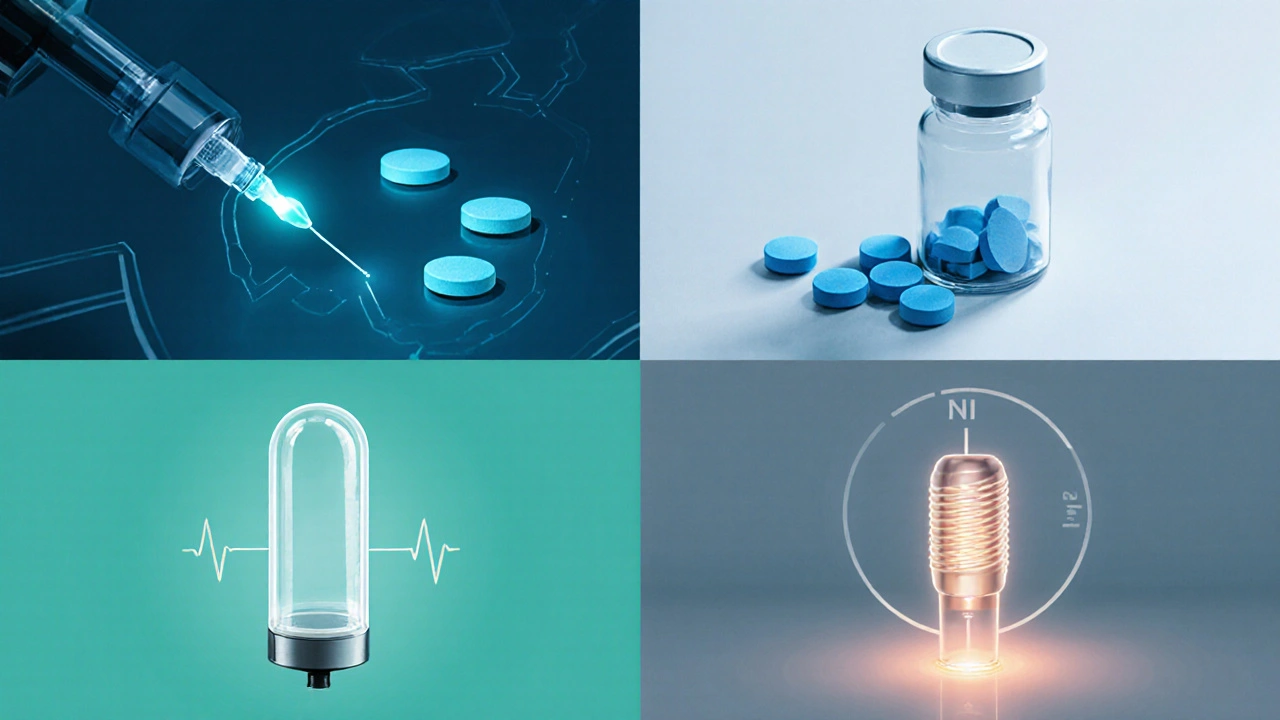
When it comes to treating erectile dysfunction (ED), the market is packed with options ranging from injections to pills to devices. Picking the right one feels like a maze, especially if you’ve never heard of Alprostadil is a synthetic prostaglandin E1 that relaxes smooth muscle and improves blood flow in the penis. This guide cuts through the clutter, compares Alprostadil with the most common alternatives, and helps you decide which route matches your lifestyle, health profile, and budget.
Alprostadil’s mechanism is straightforward: it mimics prostaglandin E1, a natural compound that dilates blood vessels. By injecting the drug directly into the corpora cavernosa (the two sponge‑like chambers of the penis) or delivering it as a urethral suppository, it bypasses the systemic pathways that oral medications rely on.
Typical candidates include men who:
Dosage starts at 2.5µg for intraurethral use and 5µg for injection, titrated upward based on response and tolerability. The effect peaks in 5‑15minutes and can last up to an hour.
Oral phosphodiesterase‑5 (PDE‑5) inhibitors dominate the ED market. They work by blocking the enzyme that degrades cyclic GMP, a molecule that relaxes smooth muscle and boosts blood flow. Below is a quick snapshot of each:
All three require sexual stimulation to work, and they share common side effects such as headache, flushing, nasal congestion, and occasional visual disturbances.
Some men prefer a cocktail of injectable agents. Papaverine, an antispasmodic, is often mixed with Alprostadil (the so‑called “bimix”) or with a third agent, phentolamine (the “trimix”). These mixtures can achieve higher erection rigidity at lower individual drug doses, reducing the risk of pain.
Key points:
If medication isn’t an option, mechanical solutions fill the gap.
Vacuum erection device is a cylinder that creates negative pressure, drawing blood into the penis; a constriction ring maintains the erection for up to 30minutes. VEDs are inexpensive, reusable, and have a low side‑effect profile, but some men find them cumbersome or experience reduced sensation.
Penile implant surgery involves placing inflatable or semi‑rigid rods within the corpora cavernosa. Implants provide a permanent solution with high satisfaction rates (>90%) but require invasive surgery, a recovery period, and carry surgical risks.

| Treatment | Common Side Effects | Serious Risks | Onset Time | Duration |
|---|---|---|---|---|
| Alprostadil (injection) | Pain, bruising, penile fibrosis | Priapism (rare), infection | 5‑15min | ~1hour |
| Alprostadil (urethral) | Urethral burning, spotting | Priapism (rare) | 10‑20min | ~30min |
| Sildenafil | Headache, flushing, dyspepsia | Vision loss (very rare), cardiovascular events | 30‑60min | 4‑6h |
| Tadalafil | Back pain, muscle aches, headache | Heart attack risk with nitrates | 30‑120min | Up to 36h |
| Vardenafil | Headache, flushing, rhinitis | Rare vision changes | 30‑60min | 4‑5h |
| Papaverine (injectable) | Local pain, nausea | Priapism, fibrosis | 5‑15min | ~1hour |
| Vacuum device | Numbness, bruising | Penile tissue injury (rare) | Immediate | 30min (with ring) |
| Penile implant | Post‑op pain, swelling | Infection, mechanical failure | Immediate after activation | Permanent |
Money often decides the final choice. Approximate US pricing (2025) for a single dose:
In the UK, many oral PDE‑5 inhibitors are available on the NHS for qualifying patients, while Alprostadil injections usually require a private prescription and are reimbursed only in limited cases. Always check with your pharmacist about any private medical insurance coverage for injectable therapies.
Following this framework helps you and your clinician narrow down the list without feeling overwhelmed.
If you’ve tried an oral pill and still can’t achieve a satisfactory erection, schedule a follow‑up with a urologist. They will likely:
Should you experience persistent pain, prolonged erection (>4hours), or signs of infection after an injection, seek medical attention immediately - these are signs of priapism or infection that need prompt treatment.
Alprostadil injected into the penis can produce an erection within 5‑15minutes, whereas Viagra (Sildenafil) usually takes 30‑60minutes after oral ingestion.
Yes, many men with diabetes use Alprostadil safely. The drug works locally, so systemic interactions are minimal, but you should still discuss dosage with your doctor, especially if you have severe peripheral vascular disease.
Mixing Alprostadil with Papaverine or Phentolamine (forming bimix or trimix) is a common practice to enhance rigidity and reduce pain. This must be done by a pharmacist‑compounded prescription and under medical supervision.
A VED can feel less spontaneous, may cause temporary bruising or reduced sensitivity, and requires a constriction ring that some men find uncomfortable. However, it’s a reliable, non‑pharmacologic option for many.
Implants are considered permanent. Removal is possible but involves another surgery, and the underlying erectile tissue may be altered after the first procedure.
There’s a lot to unpack when you compare Alprostadil with oral PDE‑5 inhibitors – the pharmacokinetics differ, the side‑effect profiles diverge, and the cost considerations shift dramatically depending on insurance coverage. In practice, the injection route bypasses systemic metabolism, which can be a boon for patients on nitrates. However, you do need proper instruction to avoid fibrosis and bruising. Bottom line: weigh the convenience of a pill against the rapid action of Alprostadil, especially if you’ve hit a wall with Viagra.
Okay so you’ve got this whole menu of ED treatments and it can feel like you’re standing in front of a vending machine that only has snack options that are all oddly specific and you’re trying to figure out which one actually satisfies the craving for a solid erection and not just a fleeting moment of hope and then you realize that the injection is like a fast‑food meal delivered in five minutes but you have to learn the proper technique and risk a tiny bruise while the pills are more like a slow‑cook that takes an hour but maybe it’s worth the patience for that relaxed vibe and sheer convenience of just popping a tablet and hoping for the best
First and foremost, the distinction between local and systemic therapy is paramount in our therapeutic algorithmic framework, especially when navigating the nuanced landscape of erectile dysfunction management. Alprostadil, being a prostaglandin E1 analog, exerts its vasodilatory effect directly at the corpora cavernosa, thereby circumventing hepatic first‑pass metabolism and obviating drug‑drug interactions that are prevalent with oral phosphodiesterase‑5 inhibitors. This pharmacodynamic advantage translates into a markedly rapid onset-typically within five to fifteen minutes-making it an optimal choice for patients requiring on‑demand spontaneity. Moreover, the dosage titration protocol, commencing at 2.5 µg for intraurethral administration and 5 µg for intracavernosal injection, provides a granular control mechanism that can be individualized based on penile hemodynamics and patient tolerance. From a safety perspective, the adverse event profile is predominantly localized, including transient pain, hematoma formation, and rare instances of fibrosis, which can be mitigated through site rotation and aseptic technique. Conversely, oral agents such as sildenafil, tadalafil, and vardenafil, while undeniably convenient, rely on systemic absorption and necessitate intact endothelial function and adequate nitric oxide synthase activity-parameters that are often compromised in diabetic or post‑prostatectomy cohorts. The systemic exposure also predisposes patients to widespread side effects like headaches, flushing, and, in the context of concomitant nitrate therapy, potentially catastrophic hypotension. In terms of pharmacoeconomics, the per‑dose cost of Alprostadil injection ($5‑$8) is competitive when considering the cumulative expense of daily oral regimens over months, particularly for younger patients engaging intermittently. Finally, the decision matrix should integrate patient‑specific variables: cardiovascular comorbidities, renal function, preference for invasiveness, and insurance reimbursement pathways. By synthesizing these data points, clinicians can tailor an evidence‑based regimen that maximizes efficacy while minimizing iatrogenic risk, thereby enhancing overall quality of life for the patient.
One has to wonder why Big Pharma is so eager to push daily pills at premium prices when a simple, locally‑administered prostaglandin can achieve the same endpoint without the entourage of systemic side‑effects or the hidden agenda of keeping us dependent on perpetual prescriptions. The corporate narratives are deliberately crafted to paint any non‑oral modality as ‘old‑fashioned’ or ‘invasive’, yet the peer‑reviewed literature is replete with long‑term safety data for Alprostadil that the slick marketing teams conveniently overlook. If you stare at the data long enough, the bias becomes unmistakable: a calculated effort to monopolize the market under the guise of convenience.
Actually, those pills are just a marketing gimmick 😂
Hey folks, just wanted to add that whatever option you choose, the most important thing is open communication with your doctor and realistic expectations – you don’t have to jump straight into surgery if a needle or a pill could work for you.
That’s true, but remember the injection technique is crucial; improper administration can lead to infection or fibrosis, so proper training is non‑negotiable.
Honestly, I always think there’s a hidden micro‑chip in these devices tracking our usage – it’s how they keep the data pipelines full for the next round of “innovations”.
While it’s easy to get caught up in conspiracy theories, the reality is that most of these tools are regulated and the data is anonymized; focusing on efficacy and comfort will serve you better than worrying about shadowy surveillance. 🌱
Thanks for the info – will check with my urologist about trying the injection first.